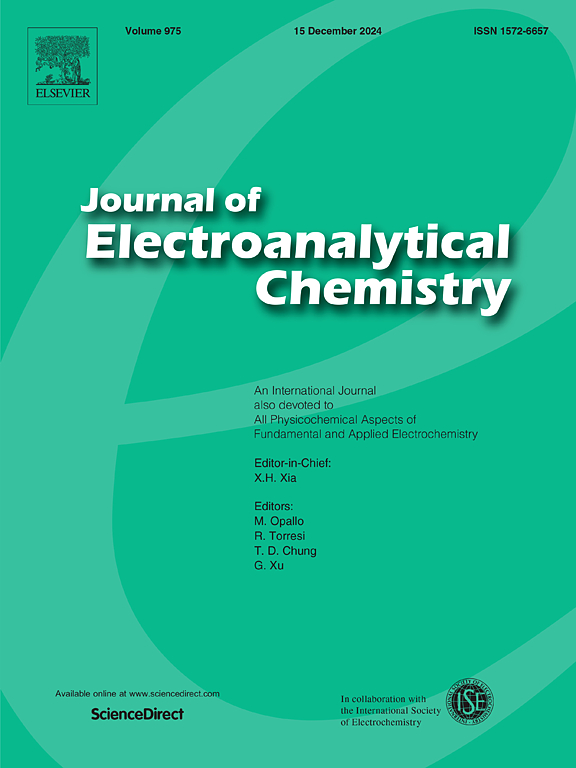Capacitive deionization for water desalination using Na3Fe2(PO4)3/activated carbon composite electrodes
IF 4.1
3区 化学
Q1 CHEMISTRY, ANALYTICAL
引用次数: 0
Abstract
Water desalination technologies are attracting growing global attention as critical solutions to address water scarcity torturing mankind worldwide. Capacitive deionization (CDI) is an emerging desalination technology that offers multiple advantages, including low voltage operation and diverse material options for electrode synthesis. In this work the Na3Fe2(PO4)3 (NFP) is composited with the activated carbon (AC) to synthesize AC/NFP composites and tested in water desalination. The characterization results from several techniques reveal the successful composite synthesis. When tested in CDI experiments for brackish water desalination much higher salt removal capacity of around 22.0 was attained by AC/NFP 1:2 compared with 18.65 mg/g of AC electrode. Also, the synthesized AC/NFP 1:2 retain satisfactorily performance efficiency when cycled for twenty runs. However, owing to low resistance at the electrode-electrolyte interface the AC is more energy efficient as it exhibits much low energy consumption of about 0.056 kWh/m3 compared with the AC/NFP 1:2 cell attained 0.15 kWh/m3. This study reveals a trade-off between performance and efficiency: while the AC/NFP 1:2 cell exhibits higher salt removal capacity, it consumes significantly more energy than the AC electrode, which demonstrate superior energy efficiency.

Na3Fe2(PO4)3/活性炭复合电极电容式去离子海水淡化
海水淡化技术作为解决世界范围内困扰人类的水资源短缺问题的关键解决方案,正引起越来越多的全球关注。电容去离子(CDI)是一种新兴的海水淡化技术,具有多种优点,包括低电压操作和多种电极合成材料选择。本文将Na3Fe2(PO4)3 (NFP)与活性炭(AC)复合,合成了AC/NFP复合材料,并进行了海水淡化试验。几种技术的表征结果表明该复合材料的合成是成功的。在CDI实验中,与18.65 mg/g的交流电极相比,AC/NFP 1:2的电极脱盐能力更高,脱盐能力约为22.0。此外,合成的AC/NFP 1:2在循环20次后仍保持令人满意的性能效率。然而,由于在电极-电解质界面的低电阻,交流电更节能,因为与达到0.15 kWh/m3的交流电/NFP 1:2电池相比,交流电的能耗低得多,约为0.056 kWh/m3。这项研究揭示了性能和效率之间的权衡:虽然AC/NFP 1:2电池具有更高的除盐能力,但它消耗的能量明显多于交流电极,后者显示出更高的能量效率。
本文章由计算机程序翻译,如有差异,请以英文原文为准。
求助全文
约1分钟内获得全文
求助全文
来源期刊
CiteScore
7.80
自引率
6.70%
发文量
912
审稿时长
2.4 months
期刊介绍:
The Journal of Electroanalytical Chemistry is the foremost international journal devoted to the interdisciplinary subject of electrochemistry in all its aspects, theoretical as well as applied.
Electrochemistry is a wide ranging area that is in a state of continuous evolution. Rather than compiling a long list of topics covered by the Journal, the editors would like to draw particular attention to the key issues of novelty, topicality and quality. Papers should present new and interesting electrochemical science in a way that is accessible to the reader. The presentation and discussion should be at a level that is consistent with the international status of the Journal. Reports describing the application of well-established techniques to problems that are essentially technical will not be accepted. Similarly, papers that report observations but fail to provide adequate interpretation will be rejected by the Editors. Papers dealing with technical electrochemistry should be submitted to other specialist journals unless the authors can show that their work provides substantially new insights into electrochemical processes.

 求助内容:
求助内容: 应助结果提醒方式:
应助结果提醒方式:


